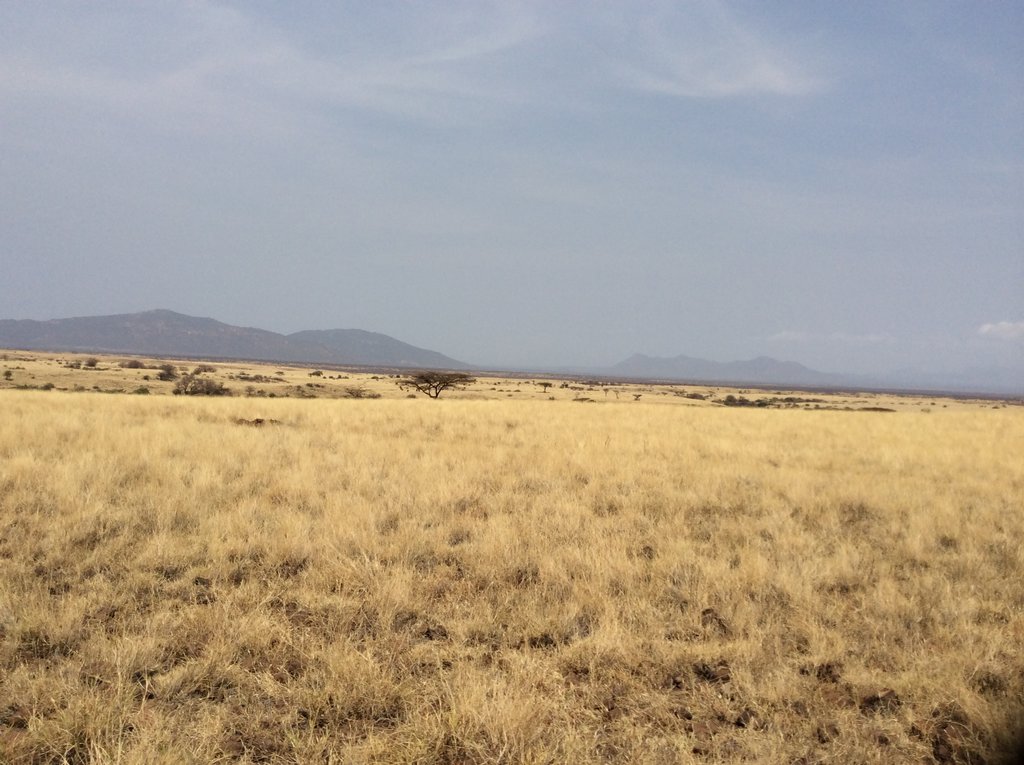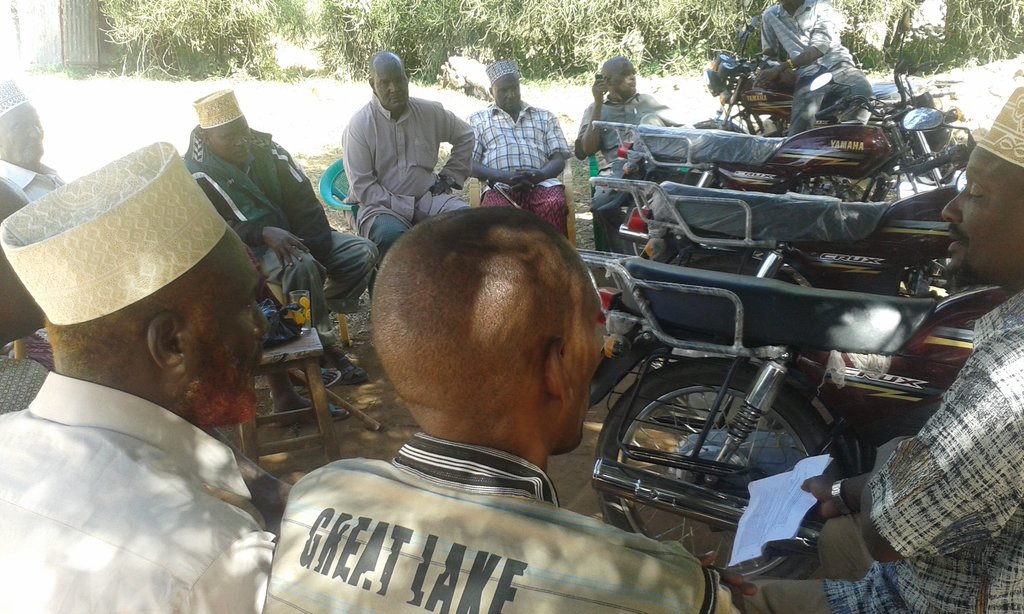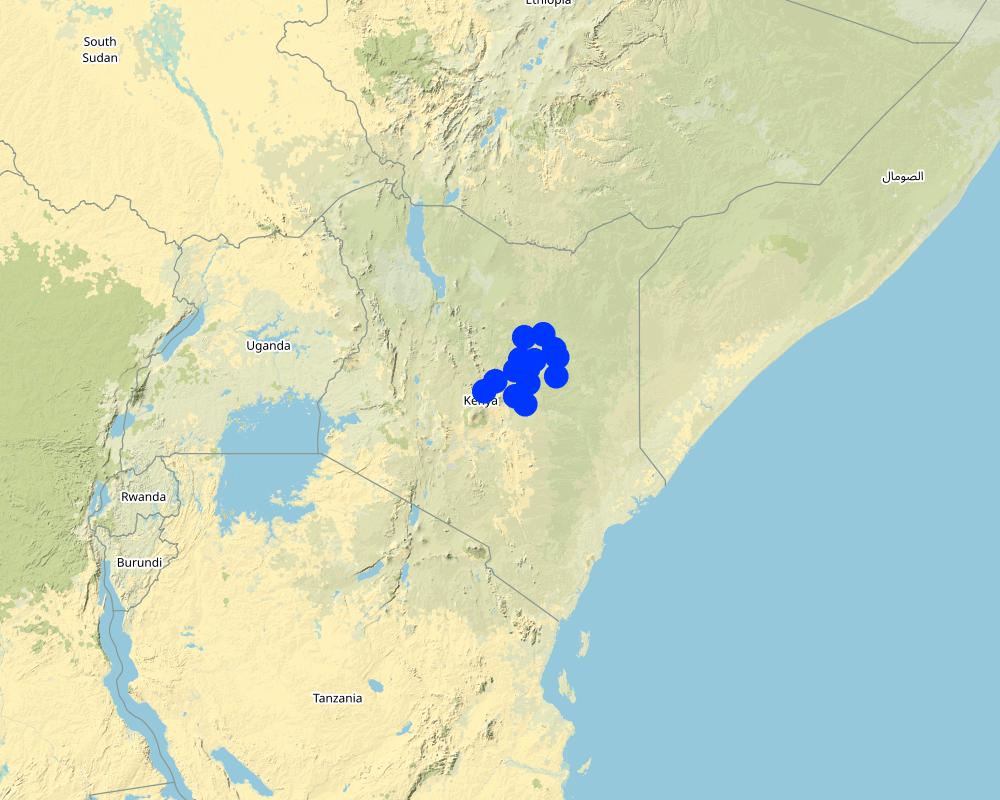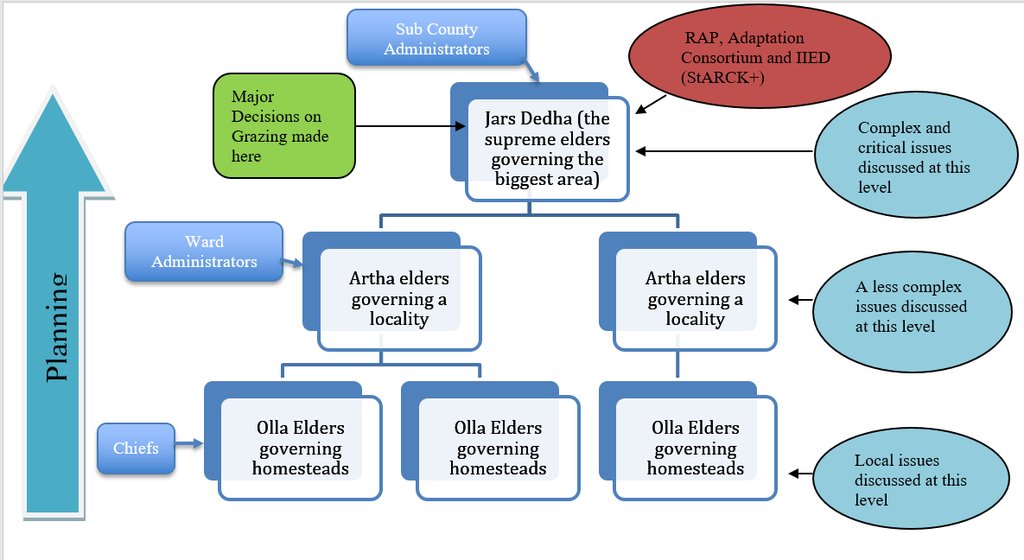Empowering Dedha institutions in governing the natural resources of Isiolo rangelands [Kenya]
- Creation:
- Update:
- Compiler: IBRAHIM JARSO
- Editor: Caroline King-Okumu
- Reviewers: Hanspeter Liniger, Rima Mekdaschi Studer, Donia Mühlematter, Joana Eichenberger
Jars Dedha
approaches_3345 - Kenya
- Full summary as PDF
- Full summary as PDF for print
- Full summary in the browser
- Full summary (unformatted)
- Empowering Dedha institutions in governing the natural resources of Isiolo rangelands: May 13, 2018 (inactive)
- Empowering Dedha institutions in governing the natural resources of Isiolo rangelands: July 31, 2018 (inactive)
- Empowering Dedha institutions in governing the natural resources of Isiolo rangelands: Sept. 3, 2018 (inactive)
- Empowering Dedha institutions in governing the natural resources of Isiolo rangelands: Nov. 2, 2021 (public)
View sections
Expand all Collapse all1. General information
1.2 Contact details of resource persons and institutions involved in the assessment and documentation of the Approach
land user:
Boru Edin
+254 715 627 545
Kinna Dedha Elders
Kinna town, Kinna Ward, Isiolo County.
Kenya
Non-State Actor:
Jama Abdiaziz
+254 707 720 577
aziz2012ke@gmail.com
Pastoralist Capacity Development Programme (PACDEP)
Isiolo Town, Kenya
Kenya
land user:
Diba Rukia
+254 728 643 044
Ward Adaptation Planning Committee
Kinna, Isiolo County
Kenya
SLM specialist:
Name of project which facilitated the documentation/ evaluation of the Approach (if relevant)
Strengthening Adaptation and Resilience to Climate Change in Kenya Plus (StARCK+)Name of project which facilitated the documentation/ evaluation of the Approach (if relevant)
Book project: Guidelines to Rangeland Management in Sub-Saharan Africa (Rangeland Management)Name of the institution(s) which facilitated the documentation/ evaluation of the Approach (if relevant)
Resource Advocacy Programme (RAP) - Kenya1.3 Conditions regarding the use of data documented through WOCAT
When were the data compiled (in the field)?
03/11/2017
The compiler and key resource person(s) accept the conditions regarding the use of data documented through WOCAT:
Yes
2. Description of the SLM Approach
2.1 Short description of the Approach
This approach – driven by communities and supported by various agencies - aims to revive and strengthen the traditional natural resource management institutions of Boran pastoralists in Northern Kenya. The traditional system, which was devised by the Boran pastoral community and honed over centuries to suit the challenges of the rangelands, has been steadily eroded by external factors and formalised systems after the emergence of the nation-state.
2.2 Detailed description of the Approach
Detailed description of the Approach:
Pastoral Community Members together with the Jarsa Dedha (the council of elders who control the use of grazing land and its resources) are at the forefront of reinvigorating traditions of rangeland management. To achieve this, they have been supported by organizations including the Ward Adaptation Planning Committees (WAPC), the Resource Advocacy Programme (RAP) and the International Institute for Environment and Development (IIED). There has been a focus on reviving traditional institutions and systems of managing of natural resources to help communities adapt to climate change.
One specific project that has assisted the re-empowerment of the Dedha institutions was StARCK+ (funded by DfID). StARCK+ was founded on an understanding and an appreciation of the traditional natural resource governance of the Boran pastoral community. Responding to participatory demand it undertook to help strengthen this customary natural resource management system. Various agencies have also conducted research on the traditional institution and investigated how it could be improved. These include IIED, (UK), the University of Nairobi, (Kenya) and the University of Sussex (UK).
The Jarsa Dedha is an indigenous institution, through which customary laws and provisions guide the management of natural resources. The Boran of Isiolo County, Kenya, like their kin in southern Ethiopia, derive their customary laws from an overall supreme general assembly called the Gadha. The Gadha governing council preserves traditional laws and codes of conduct, as well as issuing amendments and additions based on the evolving environmental, social and cultural context. The Gadha system has a set of laws and provisions (seere), customs and culture (aada), and norms and values that govern society.
The recognition and observance of seere and aada are still considered vital for the wellbeing of the community, and the Gadha Council remains a legitimate institution in the eyes of Borana society. However, adherence to these laws is declining and the power of Borana customary institutions to enforce regulations is being undermined in a number of ways.
The reasons for weakening traditional institutions are basically poor recognition by the county and national government, and non-compliance with the rules due to changing socio-cultural norms. The council of elders that govern grazing resources, the Jarsa Dedha, which is the custodian of these unwritten rules and regulations locally, no longer has sufficient capacity or authority to enforce them as it had done prior to colonial rule. With climate change, pasture and water supplies are becoming scarcer and there is no other better way to govern land than the traditional system: that is why reviving, strengthening and improving the system was much welcomed through the advent of the StARCK+ project and the initiatives and support that have followed.
Looking towards the future, the rules of governing natural resources have been collected and formed into a draft county customary natural resource governance bill. This, if passed by the County Assembly, would represent a very significant step, by legitimising the traditional system of rangeland management through the Jarsa Dedha.
2.3 Photos of the Approach
2.4 Videos of the Approach
Comments, short description:
The video clearly defines the technology and the approach
Date:
20/02/2015
Location:
Garbatulla Area
Name of videographer:
Hilda Kathure
2.5 Country/ region/ locations where the Approach has been applied
Country:
Kenya
Region/ State/ Province:
Isiolo
Further specification of location:
Pastoral areas of Isiolo
Map
×2.6 Dates of initiation and termination of the Approach
Indicate year of initiation:
2012
If precise year is not known, indicate approximate date when the Approach was initiated:
less than 10 years ago (recently)
Comments:
The project started 2012 and ended 2016 but the approach is still continuing
2.7 Type of Approach
- traditional/ indigenous
2.8 Main aims/ objectives of the Approach
The Approach is aimed at strenghthening and re-empowering the traditional institutions that govern rangeland management in the rangelands of Isiolo, in order to improve utilisation of natural resources and build community resilience to droughts and future environmental changes.
2.9 Conditions enabling or hindering implementation of the Technology/ Technologies applied under the Approach
social/ cultural/ religious norms and values
- enabling
The approach was traditional and embedded in the culture of boran pastoralists and therefore easy to implement.
- hindering
The commercialization of livestock and its production like milk has made it difficult for elders to implement the approach.
availability/ access to financial resources and services
- enabling
Communities make their own contributions to support implementation of the approach.
- hindering
No specific budget assigned by government authority for this approach: some funds from projects and county government and contributions from the pastoralists themselves.
institutional setting
- enabling
Well elaborated organizational design at all levels of institutional scale.
- hindering
Collision between the mandates of traditional structure and formal structure. This was addressed through accepting Chiefs as ex-official members in the Dedha council of elders.
collaboration/ coordination of actors
- enabling
Many NGOs and local organization support the implementation of the approach through providing means for surveillance such as vehicles or motorbikes. NGOs frequently also support Dedha assemblies that involve meetings of people from far away.
- hindering
Government and some NGOs sometimes establish parallel grazing committees.
legal framework (land tenure, land and water use rights)
- enabling
Traditional tenure system.
- hindering
No legal papers for the ownership.
policies
- enabling
Traditional provisions and rules known by all community members.
- hindering
Traditional rules not known to everyone.
land governance (decision-making, implementation and enforcement)
- enabling
Elders make key decisions on governance of land.
- hindering
Women and youth not well involved in decision making although changes are happening nowadays to include them.
knowledge about SLM, access to technical support
- enabling
Traditional skills much used.
- hindering
Little technical support.
markets (to purchase inputs, sell products) and prices
- enabling
Ensures security and market thrives.
- hindering
The approach is more social and not market oriented.
workload, availability of manpower
- enabling
Youth provide man power Voluntarily.
- hindering
Volunteers sometimes don’t come out for work.
3. Participation and roles of stakeholders involved
3.1 Stakeholders involved in the Approach and their roles
- local land users/ local communities
Boran Community members, Dedha elders.
Agree on the pasture and water management approach and implement .
- community-based organizations
Ward Adaptation Planning Committees.
Implement community plans and fundraise for it.
- NGO
Resource Advocacy Programme (RAP), Merti Integrated Development Programme (MIDP), Pastoralist A Capacity Development E Programme (PACDEP), International Institute for Environment Development and Adaptation Consortium (ADA)
Support communities in implementing the approach.
Ward Adaptation Planning Committees; Implement community plans and fundraise for it.
If several stakeholders were involved, indicate lead agency:
WAPC , ADA and IIED
3.2 Involvement of local land users/ local communities in the different phases of the Approach
| Involvement of local land users/ local communities | Specify who was involved and describe activities | |
|---|---|---|
| initiation/ motivation | interactive | Pastoral Community Members, Dedha elders and supporting organizations like WAPC, RAP, IIED and DfID supported the process of reviving the traditional system of management of natural resources to help communities adapt to climate change. |
| planning | interactive | Pastoral Community Members and Dedha Elders to improve their systems of management of land and land-based resources. |
| implementation | interactive | Dedha elders as they are tasked with ensuring that the natural resource governance system is successful. |
| monitoring/ evaluation | interactive | Pastoralists and elders to keep those tasked are properly undertaking the responsibilities. |
3.3 Flow chart (if available)
Description:
The Dedha traditional system of managing resources has internal hierarchy at different levels i.e. Olla (homestead), Artha (locality) and Dedha (a large area). Although planning and minor decisions are made at local levels, major and binding decisions are agreed at Dedha level on grazing and management of pasture. Many NGOs and government actors engage the management system at Dedha level.
Author:
Ibrahim Jarso
3.4 Decision-making on the selection of SLM Technology/ Technologies
Specify who decided on the selection of the Technology/ Technologies to be implemented:
- all relevant actors, as part of a participatory approach
Explain:
The Participatory process is very essential in making the governance system work for pastoralists.
Specify on what basis decisions were made:
- personal experience and opinions (undocumented)
4. Technical support, capacity building, and knowledge management
4.1 Capacity building/ training
Was training provided to land users/ other stakeholders?
Yes
Specify who was trained:
- land users
If relevant, specify gender, age, status, ethnicity, etc.
Largely elders but women and youth are also represented in the training.
Form of training:
- on-the-job
- farmer-to-farmer
- public meetings
Subjects covered:
Constitutional clauses supporting management of land through traditional institutions.
Need to legislate the local traditional rules to county laws. Participatory mapping of Natural Resources in the grazing areas to improve planning.
Comments:
Community members really participated in the processes and trainings and understood the contemporary issues.
4.2 Advisory service
Do land users have access to an advisory service?
Yes
Specify whether advisory service is provided:
- at permanent centres
Describe/ comments:
The pastoralist extension training sessions take place in Agricultural Training Centre in Isiolo Town. They are normally conducted once or twice a year because of financial constraints.
4.3 Institution strengthening (organizational development)
Have institutions been established or strengthened through the Approach?
- yes, greatly
Specify the level(s) at which institutions have been strengthened or established:
- local
Describe institution, roles and responsibilities, members, etc.
The Dedha institution has been strengthened as they were enabled to undertake their responsibilities better.
Specify type of support:
- equipment
- Their meetings were supported and made frequent and increased reach.
Give further details:
Provided with materials like motorbikes.
4.4 Monitoring and evaluation
Is monitoring and evaluation part of the Approach?
Yes
Comments:
This is a traditional approach and it is effectively self-monitored for learning and improvement.
If yes, is this documentation intended to be used for monitoring and evaluation?
Yes
4.5 Research
Was research part of the Approach?
Yes
Specify topics:
- sociology
- economics / marketing
- ecology
- technology
Give further details and indicate who did the research:
Various institutions have conducted research on the traditional institution and investigated how it could be improved through strengthening and reviving it with new initiatives for improved governance of natural resources. The institutions are the International Institute for Environment and Development, (UK), the University of Nairobi, (Kenya) and the University of Sussex (UK).
5. Financing and external material support
5.1 Annual budget for the SLM component of the Approach
Comments (e.g. main sources of funding/ major donors):
The traditional system is self sustaining and thrives through local contributions but no specific budget lines.
5.2 Financial/ material support provided to land users
Did land users receive financial/ material support for implementing the Technology/ Technologies?
No
5.3 Subsidies for specific inputs (including labour)
- none
If labour by land users was a substantial input, was it:
- voluntary
Comments:
The land users are pastoralists and surveillance of grazing reserves were undertaken to protect their pastures from irregular access. Dedha elders oversee the surveillance and health of rangelands.
5.4 Credit
Was credit provided under the Approach for SLM activities?
No
5.5 Other incentives or instruments
Were other incentives or instruments used to promote implementation of SLM Technologies?
Yes
If yes, specify:
The rules of governing natural resources were collected and documented into a county customary natural resource governance bill.
6. Impact analysis and concluding statements
6.1 Impacts of the Approach
Did the Approach empower local land users, improve stakeholder participation?
- No
- Yes, little
- Yes, moderately
- Yes, greatly
Strengthens community rights and ownership of their land.
Did the Approach enable evidence-based decision-making?
- No
- Yes, little
- Yes, moderately
- Yes, greatly
The Approach convened the community and identified the community challenges and worked on it with the support of Dedha elders.
Did the Approach help land users to implement and maintain SLM Technologies?
- No
- Yes, little
- Yes, moderately
- Yes, greatly
Supported the essential activities of the traditional system and made it easy to implement.
Did the Approach improve coordination and cost-effective implementation of SLM?
- No
- Yes, little
- Yes, moderately
- Yes, greatly
Improved coordination among the partners and made implementation easy.
Beside getting support from County climate adaptation program through the Ward Adaptation Planning Committee, the approach also got support from Water Sector Trust Fund.
Did the Approach improve knowledge and capacities of land users to implement SLM?
- No
- Yes, little
- Yes, moderately
- Yes, greatly
The knowledge is culturally passed to generations
Did the Approach improve knowledge and capacities of other stakeholders?
- No
- Yes, little
- Yes, moderately
- Yes, greatly
Yes, other stakeholders’ knowledge on the system was also improved.
Did the Approach build/ strengthen institutions, collaboration between stakeholders?
- No
- Yes, little
- Yes, moderately
- Yes, greatly
Yes, the Approach made local indigenous institution stronger and enhanced their collaboration.
Did the Approach mitigate conflicts?
- No
- Yes, little
- Yes, moderately
- Yes, greatly
It provided platform for resource based conflict discussions and also settled many of local and trans-boundary conflicts through the empowered Dedha elders
Did the Approach empower socially and economically disadvantaged groups?
- No
- Yes, little
- Yes, moderately
- Yes, greatly
Yes, the approached saved livestock from death in times of drought and built pastoral communities economically.
Did the Approach improve gender equality and empower women and girls?
- No
- Yes, little
- Yes, moderately
- Yes, greatly
The aAproach engaged the Dedha elders to accept women in their traditional institutions and entrenched gender in establishment of WAPCs
Did the Approach encourage young people/ the next generation of land users to engage in SLM?
- No
- Yes, little
- Yes, moderately
- Yes, greatly
Many youth were involved in implementing the Traditional systems of governance as a result of the approach
Did the Approach improve issues of land tenure/ user rights that hindered implementation of SLM Technologies?
- No
- Yes, little
- Yes, moderately
- Yes, greatly
Yes, the Approach led to formulation of customary natural resource management bill meant to enhance land rights.
Did the Approach lead to improved food security/ improved nutrition?
- No
- Yes, little
- Yes, moderately
- Yes, greatly
Yes, through ensuring retention of livestock asset.
Did the Approach improve access to markets?
- No
- Yes, little
- Yes, moderately
- Yes, greatly
The Approach through improvement of range management institution of Dedha, has helped to ensure there is food for pastoral herds and livestock with good body conditions were sold in local markets in good prices
Did the Approach lead to improved access to water and sanitation?
- No
- Yes, little
- Yes, moderately
- Yes, greatly
Yes, through the approach many water facilities were better managed.
Did the Approach improve the capacity of the land users to adapt to climate changes/ extremes and mitigate climate related disasters?
- No
- Yes, little
- Yes, moderately
- Yes, greatly
Yes, the Approach empowered the community to arrange their pattern of grazing to wet, dry season and grazing reserves to cope with climate extremes and disasters.
Did the Approach lead to employment, income opportunities?
- No
- Yes, little
- Yes, moderately
- Yes, greatly
Yes, many job opportunities were created for locals and also private businesses.
6.2 Main motivation of land users to implement SLM
- increased production
The livestock was calving and reproducing very fast leading to increased production as a result of good management of land.
- increased profit(ability), improved cost-benefit-ratio
With minimal and voluntary inputs the pastoralists keep livestock in the range and make a lot of profit when they sell.
- reduced land degradation
The controlled grazing pattern led to regeneration of degraded rangelands and improved its ecosystem services.
- reduced risk of disasters
With strengthened dedha elders the community were able to prepare very well to drought and other disasters.
- reduced workload
Available pasture when needed reduced the challenges of mobility to far areas and excess workload.
- prestige, social pressure/ social cohesion
The approach enhances local prestige and also reduces the incidences of conflict in tough times enhancing social cohesion.
- environmental consciousness
The approach allows regeneration of natural vegetation as pastoralists preserve pasture in one grazing area as they grazing in the other.
- customs and beliefs, morals
The approach uses traditional etiquettes which enhances customs and beliefs.
- enhanced SLM knowledge and skills
The approach allows young people to learn and attain new knowledge on proper governance of natural resources as well the elders attain new contemporary skills to manage land.
- aesthetic improvement
The preserved grazing areas allows pasture to blossom and very beautiful to the eye as ecosystems regenerates and gets in to new life.
- conflict mitigation
The approach reduces incidences of conflict as the use and stewardship of pasture and water is clearly defined.
6.3 Sustainability of Approach activities
Can the land users sustain what has been implemented through the Approach (without external support)?
- yes
If yes, describe how:
The traditional system of managing natural resources for pastoralists has been in place for time immemorial and it supports their way of life and even if there is minimal support from outside, such as the empowering approach, the SLM will still continue as it was developed by Boran pastoralists – who feel it is the most legitimate and appropriate system of governing rangelands in the region. This has been confirmed by many analytical studies of the system.
6.4 Strengths/ advantages of the Approach
| Strengths/ advantages/ opportunities in the land user’s view |
|---|
| It is inherent approach that will pass to the next generation of pastoralists with the new innovations that are incorporated over the years. |
| It is the cheapest and easiest way of managing the rangelands for posterity. |
| It is a very flexible approach that's accepting new changes so that the technology is conversant at all times. |
| Strengths/ advantages/ opportunities in the compiler’s or other key resource person’s view |
|---|
| It is a legitimate system recognized by all pastoralist for management of their rangeland resources. |
| It is conservative and less costly to implement in the vast rangelands with little incentives. |
6.5 Weaknesses/ disadvantages of the Approach and ways of overcoming them
| Weaknesses/ disadvantages/ risks in the land user’s view | How can they be overcome? |
|---|---|
| There is no law protecting it. | The government need to establish a law that recognizes and protects the approach. |
| The changing social norms with globalization and diversification of livelihood is pausing a challenge like Commercial Pastoralism | Government need to establish policies and plans as well as legislations that recognizes the traditional systems and institution for the approach to be successful for long |
| Weaknesses/ disadvantages/ risks in the compiler’s or other key resource person’s view | How can they be overcome? |
|---|---|
| There are many competing claims over rangeland resources and government supports some. | Create awareness of local leaders about the competing claims and lobby them to protect rangeland resources. |
7. References and links
7.1 Methods/ sources of information
- field visits, field surveys
2 visits
- interviews with land users
6 interviews
- compilation from reports and other existing documentation
2
7.2 References to available publications
Title, author, year, ISBN:
Evolving pastoralists institutions by patison and tari
Available from where? Costs?
IIED Website
7.3 Links to relevant information which is available online
Title/ description:
Evolving customary institutions by patison and tari
URL:
pubs.iied.org/pdfs/10076IIED.pdf
Title/ description:
Strengthening Customary institutions the case of Isiolo County Northern Kenya by Caroline, Tari and Jarso
URL:
www.celep.info/wp-content/uploads/2015/11/Strengthening-local-institutions.pdf
Title/ description:
Investing in institutional ‘software’ to build climate resilience
URL:
https://anglejournal.com/article/2015-06-investing-in-institutional-software-to-build-climate-resilience/
Title/ description:
Inclusive green growth in Kenya: Opportunities in the dryland water and rangeland sectors
URL:
http://pubs.iied.org/10137IIED/
Title/ description:
Vegetation resources and their economic importance in Isiolo County, Kenya
URL:
http://pubs.iied.org/10141IIED/
Links and modules
Expand all Collapse allLinks
No links
Modules
No modules







